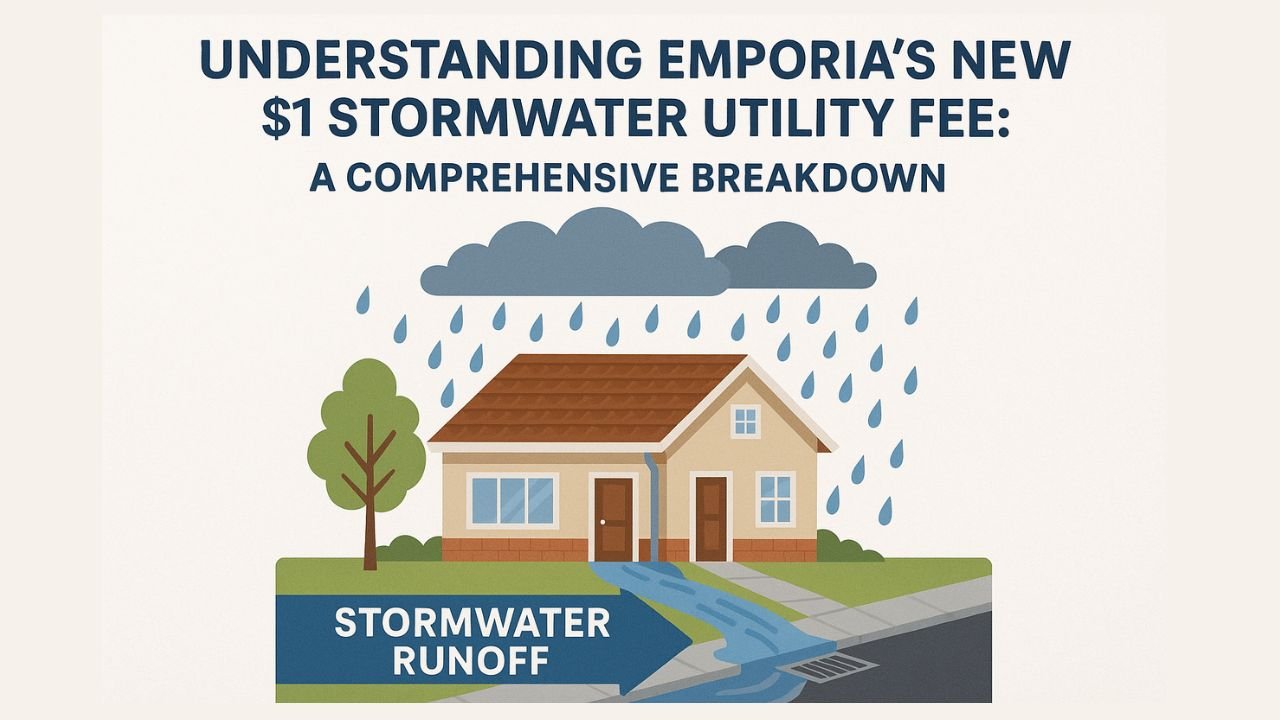On June 4, the Emporia City Commission officially gave the green light to a new stormwater utility fund, aimed exclusively at supporting future stormwater infrastructure upgrades.
The decision follows years of internal discussions, with Jim Ubert, the current Emporia City Engineer, confirming that the idea has been circulating since at least 2017, raised by prior engineers as a necessary solution for managing the city’s stormwater runoff challenges.
Why a Stormwater Utility Fee?
Stormwater management is crucial for cities to prevent flooding, erosion, and pollution of water bodies. Unlike drinking water or wastewater, which are already supported by utility fees, stormwater runoff has historically lacked a dedicated funding mechanism in many municipalities.
With increased urban development and aging infrastructure, Emporia officials recognized the need for a sustainable financial structure to fund long-term stormwater solutions.
The approved stormwater utility fee addresses this gap by creating a predictable revenue stream that can be used exclusively for designing, maintaining, and improving stormwater systems such as drainage basins, culverts, and underground pipelines.
How the Fee Works: ERU Explained
The newly adopted fee is structured around the concept of Equivalent Residential Units (ERU)—a widely accepted billing model used across Kansas. In fact, 23 out of 26 Cities of the First Class in Kansas currently use the ERU system to calculate stormwater utility fees.
Under this model:
- One ERU equals 3,000 square feet of impervious surface area on a property.
- Impervious surfaces are defined as areas that prevent water from soaking into the ground, such as rooftops, sidewalks, driveways, and paved streets.
- The more impervious surface a property has, the more runoff it generates—and consequently, the more it contributes to the strain on the city’s stormwater system.
Jim Ubert elaborated that properties with larger non-permeable surfaces will bear a slightly higher fee, reflecting their greater impact on the city’s drainage infrastructure.
For most single-family homes, the fee is projected to start at just $1 per month per ERU, making it an affordable yet effective solution for ongoing maintenance and capital improvements.
Who Pays and What It Covers
This fee will be charged to both residential and commercial property owners based on the total impervious area on their property. While residential homes typically account for one ERU, commercial or industrial properties with larger roofs and parking lots may be charged for multiple ERUs.
The revenue collected through this fee will be allocated to projects such as:
- Upgrading aging stormwater pipes and culverts
- Improving street drainage
- Installing or repairing storm drains
- Preventative maintenance for flood-prone zones
By tying the cost directly to property characteristics, the city ensures a fair and proportionate funding system that reflects actual usage and impact.
This initiative not only supports critical infrastructure but also encourages responsible land use planning. Emporia’s proactive approach ensures that all property owners contribute fairly to a cleaner, safer, and flood-resilient community.
Benefits of the New Fee
The stormwater utility fee is expected to:
- Ensure dedicated funding for critical stormwater projects without relying on general city budgets or tax increases.
- Enhance the city’s resilience to severe weather events, particularly flooding.
- Comply with state and federal environmental regulations more effectively.
- Promote equity, as each property owner contributes in proportion to the burden their property places on the system.
The $1 stormwater utility fee marks a significant step forward in how Emporia addresses its stormwater management needs.
By introducing a fair, data-driven, and scalable fee structure, the city aims to invest proactively in infrastructure that safeguards property, improves public safety, and maintains environmental standards.
As stormwater challenges grow with climate change and urban expansion, this newly established utility fund ensures Emporia is not only reacting to issues but preparing for them well in advance.




